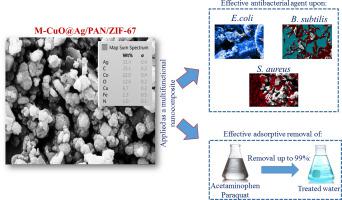Journal of Water Process Engineering ( IF 6.3 ) Pub Date : 2022-08-05 , DOI: 10.1016/j.jwpe.2022.103025 Payam Arabkhani , Arash Asfaram , Mojtaba Aghaei-Jazeh , Mohamed Ateia

|
Wastewaters are contaminated with both biological and chemical pollutants that must be eliminated before reuse and/or disposal to surface waters. This paper proposes a new magnetic CuO-doped silver/polyacrylonitrile/zeolitic imidazolate framework-67 nanocomposite (M-CuO@Ag/PAN/ZIF-67) that has multifunctional behavior for removing acetaminophen (ACT) and paraquat (PQ) residuals from contaminated water while also acting as an antibacterial agent. The antibacterial agent of as-prepared nanocomposite on Gram-positive bacteria, Staphylococcus-aureus (S. aureus), and Bacillus subtilis (B. subtilis), and also Gram-negative bacteria Escherichia coli (E. coli) were studied. To minimize the use of harmful chemicals and solvents, Fe3O4, Ag, and CuO nanoparticles were prepared through plant-mediated green synthesis by renewable, and non-toxic aqueous extracts of aloe vera plant, mulberry leaves, and Gundelia tournefortii L, respectively. The adsorption results showed that the nanocomposite could remove 99.41 ± 2.21 % of the ACT and 99.23 ± 1.83 % of the PQ from the contaminated water. The Langmuir maximum adsorption capacity of ACT and PQ by nanocomposite was calculated as 971.6 and 1143.7 mg g−1, respectively, which surpasses that of most nanocomposite-based adsorbents. Also, the adsorption kinetic data were well described with the pseudo-second-order model and the adsorption thermodynamic results showed the adsorption process was endothermic and spontaneous in nature. The antibacterial properties of nanocomposite were studied by pour plate and disk diffusion methods. It was concluded that bacterial suppression by the nanocomposite was higher in the Gram-positive bacteria than in the Gram-negative bacterium. The antibacterial results also showed that the collective antibacterial effects of the nanocomposite are stronger than its components and copper oxide-doped has also strengthened the antibacterial properties. In addition, the nanocomposite could be easily regenerated by washing with methanol, and chlorination method. Finally, the adsorption efficiency and antibacterial behavior of nanocomposite remained above 80 % and 90 % after six reuse cycles, respectively.
中文翻译:

植物介导的绿色合成纳米复合基多功能吸附剂具有抗菌活性和高去除污染水中微污染物的效率
废水被生物和化学污染物污染,必须在再利用和/或排放到地表水之前消除这些污染物。本文提出了一种新型磁性 CuO 掺杂银/聚丙烯腈/沸石咪唑酯骨架 67 纳米复合材料 (M-CuO@Ag/PAN/ZIF-67),该复合材料具有去除污染中对乙酰氨基酚 (ACT) 和百草枯 (PQ) 残留物的多功能行为。水,同时也起到抗菌剂的作用。所制备的纳米复合材料对革兰氏阳性菌、金黄色葡萄球菌(S. aureus)和枯草芽孢杆菌(B. subtilis)以及革兰氏阴性菌大肠杆菌(E.coli )的抗菌剂) 进行了研究。为了尽量减少有害化学物质和溶剂的使用,通过植物介导的绿色合成,通过芦荟植物、桑叶和Gundelia tournefortii L的可再生且无毒的水提取物,制备了Fe 3 O 4 、Ag 和 CuO 纳米颗粒,分别。吸附结果表明,纳米复合材料可以从污染水中去除 99.41 ± 2.21 % 的 ACT 和 99.23 ± 1.83 % 的 PQ。纳米复合材料对 ACT 和 PQ 的 Langmuir 最大吸附容量计算为 971.6 和 1143.7 mg g -1,分别超过了大多数基于纳米复合材料的吸附剂。此外,吸附动力学数据用准二级模型很好地描述了,吸附热力学结果表明吸附过程本质上是吸热和自发的。采用倾板扩散法和圆盘扩散法研究了纳米复合材料的抗菌性能。得出的结论是,纳米复合材料对革兰氏阳性菌的细菌抑制作用高于革兰氏阴性菌。抗菌结果还表明,纳米复合材料的集体抗菌作用强于其组分,掺杂氧化铜也增强了抗菌性能。此外,该纳米复合材料可通过甲醇洗涤和氯化法轻松再生。最后,











































 京公网安备 11010802027423号
京公网安备 11010802027423号